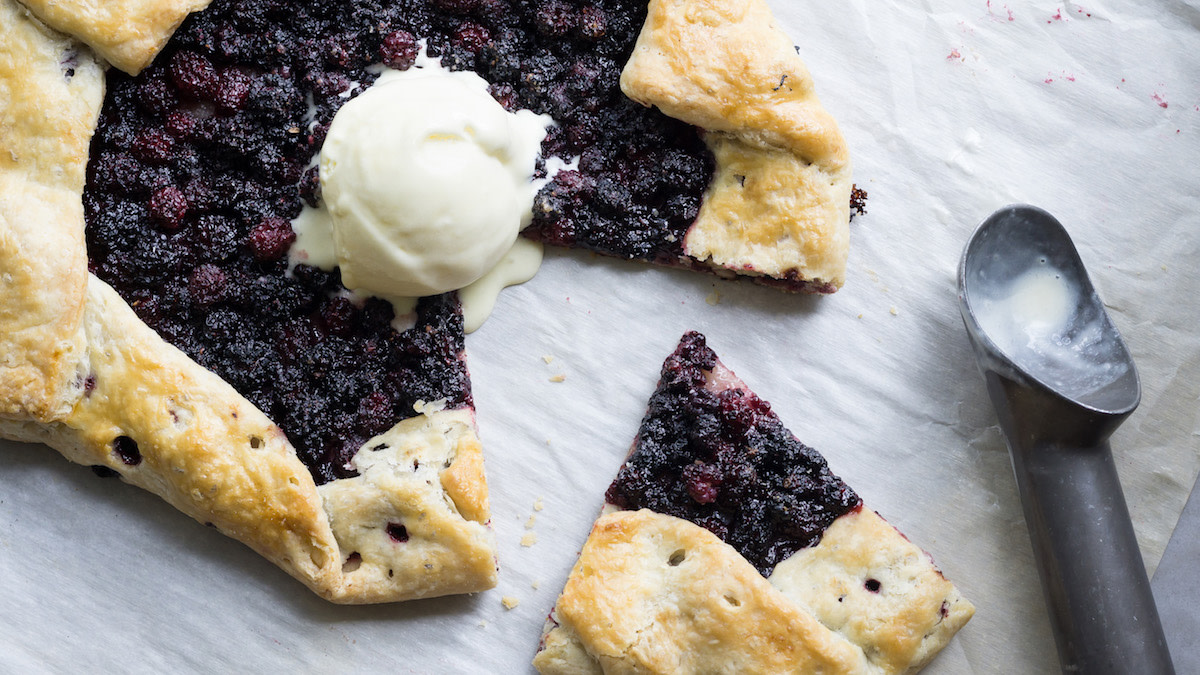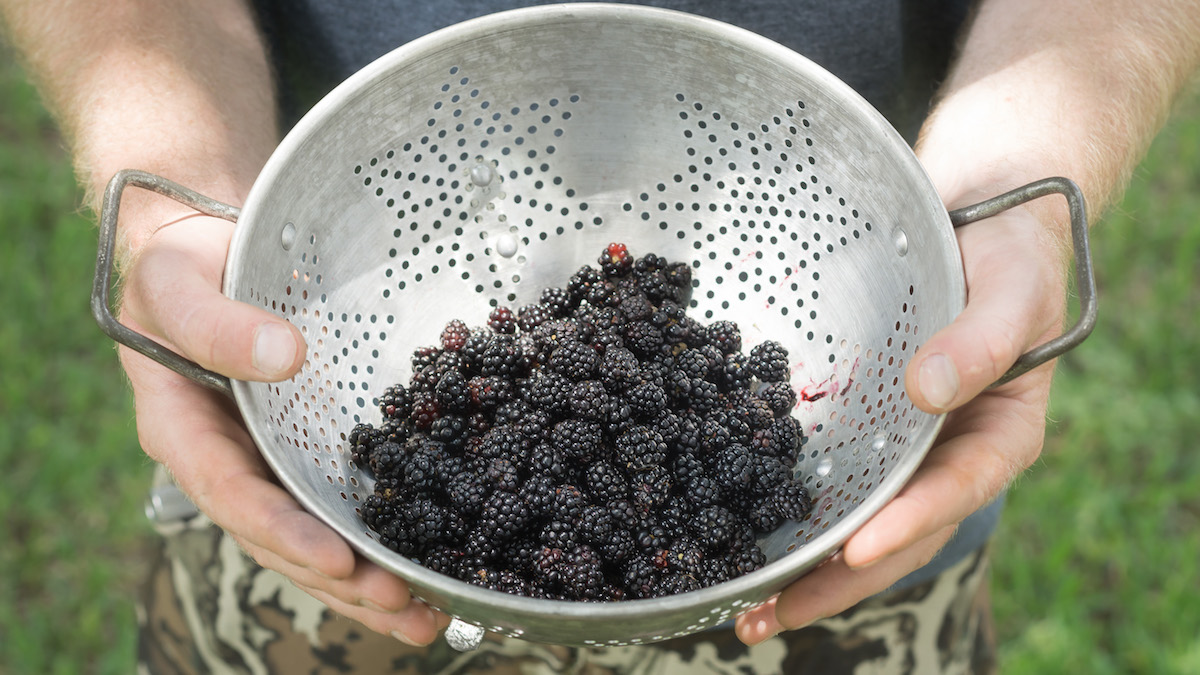
Prep time
1 hour
Cook time
45 minutes
Course
Dessert
Skill level
Intermediate
Season
Summer
Serves
11" galette
Dewberries, a tart relative to blackberries, grow wild in the South. This season I harvested a small bowl’s worth and plan on incorporating them into a sweet, rich galette.
Galettes are similar to pies, but way less fussy. The dough is rolled out into a free form, filled with wild dewberries and served with a scoop of sweetcorn ice cream. It’s my go-to dessert for backyard BBQs.
For this recipe, I used my last bit of hog lard left for the pie crust. Using wild fat makes the galette savory and extra flaky.
Up until the early 20th century, pastries were made using a blend of lard and butter. Shortening was invented and used as an alternative to animal fat because it was cheaper to produce. The consistency of hydrogenated vegetable oils proved to be more forgiving than lard because of its softness, and it has since been adopted by many. However, nothing beats the flavor and texture of pie dough made with ingredients from an animal you shot, butchered and prepared.
Making pie dough from tallow or lard is more challenging because it’s hard and brittle at room temperature. With some patience and practice, though, you can successfully cut it into the dough. When the crust is rolled out, you should be able to see small flecks of lard scattered across it. While the galette cooks at high heat, the fat melts and leaves pockets between the layers. This results in a tender, flaky texture, and makes every scratch that I got while picking these worth it.
Ingredients
Crust
- 4 tbsp. butter, chopped and chilled
- 4 tbsp. rendered wild lard or tallow
- 1 cup AP flour, plus extra
- ½ tsp. salt
- 1 tsp. sugar
- ¼ cup ice water
- 1 egg, beaten
Filling
- 3 cups of wild berries
- 2 tsp. corn starch
- 1 cup sugar
Also works with
Special equipment
Preparation
- If the rendered lard or tallow is jarred in a solid form, you will need to liquify it to measure the amount needed. Heat a small pot filled with a little water and place the jar inside. Let the steam gently melt the lard into liquid form. Pour into a measuring cup until you reach a ¼ cup (4 tbsp.).
- Pour the melted lard into a large bowl and let it cool to its hardened form. It shouldn’t take long, but you can use an ice bath to speed the process up. Use a metal spoon and scrape it from the bottom of the bowl, letting it chip and break into small pieces. Use a pastry blender to chop it until you reach evenly sized particles. If you really want a consistent, smooth texture in the pie dough, you can pulse it in a small food processor.
- Add the cold butter pieces, flour, salt and sugar to the bowl with lard. Use the pastry blender to break the butter and lard into small, pea sized bits again. This part takes some time since you want it to be evenly distributed throughout the flour as best as you can. If using a soft fat, you can use your fingers to smear and mix it into the flour.
- Slowly pour ⅓ of the ice water into the flour. Continue to mix with the pastry blender, then slowly pour the remaining water in. Mix until the water is absorbed into the flour and sticks together in a clump.
- Sprinkle a clean surface with flour. Form the pie dough into a ball, but be careful not overwork the dough. Wrap the ball of dough tight in plastic wrap and let it rest in the fridge for at least half an hour before cooking.
- Preheat an oven to 375°F. Take the pie dough out of the fridge and set it on a clean surface sprinkled with more flour. Using a rolling pin, start pushing from the center out, only rolling straight up and down (not side to side). In one motion, pick up the edge of the dough, give it a ¼ turn and sweep more flour underneath. Roll again from top to bottom. Continue this motion until the pie dough has reached roughly an 11” radius. Sprinkle with flour at any time if it starts to stick. Transfer to a large sheet of parchment and set on a sheet tray.
- Make the filling by mixing the berries, corn starch and sugar in a bowl. Pour the filling into the center of the pie crust. Fold the edges of the crust over the filling all the way around.
- Make an egg wash by beating the egg and one tablespoon of water or milk with a fork. Brush the crust with the wash for color and to use as glue to make the edges stick when folded over.
- Bake in the oven for 35 to 45 minutes or until golden brown.
Sign In or Create a Free Account
Reviews
Wild Berry Galette

Prep time
1 hour
Cook time
45 minutes
Course
Dessert
Skill level
Intermediate
Season
Summer
Serves
11" galette
Dewberries, a tart relative to blackberries, grow wild in the South. This season I harvested a small bowl’s worth and plan on incorporating them into a sweet, rich galette.
Galettes are similar to pies, but way less fussy. The dough is rolled out into a free form, filled with wild dewberries and served with a scoop of sweetcorn ice cream. It’s my go-to dessert for backyard BBQs.
For this recipe, I used my last bit of hog lard left for the pie crust. Using wild fat makes the galette savory and extra flaky.
Up until the early 20th century, pastries were made using a blend of lard and butter. Shortening was invented and used as an alternative to animal fat because it was cheaper to produce. The consistency of hydrogenated vegetable oils proved to be more forgiving than lard because of its softness, and it has since been adopted by many. However, nothing beats the flavor and texture of pie dough made with ingredients from an animal you shot, butchered and prepared.
Making pie dough from tallow or lard is more challenging because it’s hard and brittle at room temperature. With some patience and practice, though, you can successfully cut it into the dough. When the crust is rolled out, you should be able to see small flecks of lard scattered across it. While the galette cooks at high heat, the fat melts and leaves pockets between the layers. This results in a tender, flaky texture, and makes every scratch that I got while picking these worth it.
Ingredients
Crust
- 4 tbsp. butter, chopped and chilled
- 4 tbsp. rendered wild lard or tallow
- 1 cup AP flour, plus extra
- ½ tsp. salt
- 1 tsp. sugar
- ¼ cup ice water
- 1 egg, beaten
Filling
- 3 cups of wild berries
- 2 tsp. corn starch
- 1 cup sugar
Also works with
Special equipment
Preparation
- If the rendered lard or tallow is jarred in a solid form, you will need to liquify it to measure the amount needed. Heat a small pot filled with a little water and place the jar inside. Let the steam gently melt the lard into liquid form. Pour into a measuring cup until you reach a ¼ cup (4 tbsp.).
- Pour the melted lard into a large bowl and let it cool to its hardened form. It shouldn’t take long, but you can use an ice bath to speed the process up. Use a metal spoon and scrape it from the bottom of the bowl, letting it chip and break into small pieces. Use a pastry blender to chop it until you reach evenly sized particles. If you really want a consistent, smooth texture in the pie dough, you can pulse it in a small food processor.
- Add the cold butter pieces, flour, salt and sugar to the bowl with lard. Use the pastry blender to break the butter and lard into small, pea sized bits again. This part takes some time since you want it to be evenly distributed throughout the flour as best as you can. If using a soft fat, you can use your fingers to smear and mix it into the flour.
- Slowly pour ⅓ of the ice water into the flour. Continue to mix with the pastry blender, then slowly pour the remaining water in. Mix until the water is absorbed into the flour and sticks together in a clump.
- Sprinkle a clean surface with flour. Form the pie dough into a ball, but be careful not overwork the dough. Wrap the ball of dough tight in plastic wrap and let it rest in the fridge for at least half an hour before cooking.
- Preheat an oven to 375°F. Take the pie dough out of the fridge and set it on a clean surface sprinkled with more flour. Using a rolling pin, start pushing from the center out, only rolling straight up and down (not side to side). In one motion, pick up the edge of the dough, give it a ¼ turn and sweep more flour underneath. Roll again from top to bottom. Continue this motion until the pie dough has reached roughly an 11” radius. Sprinkle with flour at any time if it starts to stick. Transfer to a large sheet of parchment and set on a sheet tray.
- Make the filling by mixing the berries, corn starch and sugar in a bowl. Pour the filling into the center of the pie crust. Fold the edges of the crust over the filling all the way around.
- Make an egg wash by beating the egg and one tablespoon of water or milk with a fork. Brush the crust with the wash for color and to use as glue to make the edges stick when folded over.
- Bake in the oven for 35 to 45 minutes or until golden brown.







